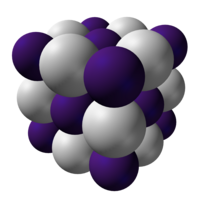Caesium hydride
 Caesium cation, Cs+ Hydrogen anion, H− | |
| Names | |
|---|---|
| IUPAC name
Caesium hydride
| |
| Other names
Cesium hydride
| |
| Identifiers | |
3D model (
JSmol ) |
|
| ChemSpider | |
PubChem CID
|
|
CompTox Dashboard (EPA)
|
|
| |
| |
| Properties | |
| CsH | |
| Molar mass | 133.91339 g/mol |
| Appearance | White or colorless crystals or powder[1] |
| Density | 3.42 g/cm3[1] |
| Melting point | ~170 °C (decomposes)[1] |
| Structure | |
| Face centered cubic | |
| Octahedral | |
| Related compounds | |
Other anions
|
|
Other cations
|
|
Except where otherwise noted, data are given for materials in their standard state (at 25 °C [77 °F], 100 kPa).
| |
Caesium hydride or cesium hydride is an
alkali metal hydride
.
It was the first substance to be created by light-induced particle formation in metal vapor,ion propulsion system using caesium.[3] It is the most reactive stable alkaline metal hydride of all. It is a powerful superbase
and reacts with water extremely vigorously.
The caesium nuclei in CsH can be hyperpolarized through interactions with an
optically pumped caesium vapor in a process known as spin-exchange optical pumping (SEOP). SEOP can increase the nuclear magnetic resonance (NMR) signal of caesium nuclei by an order of magnitude.[4]
It is very difficult to make caesium hydride in a pure form. Caesium hydride can be produced by heating
°C.[5]
Crystal structure
At room temperature and atmospheric pressure, CsH has the same structure as
NaCl
.
References
- ^ ISBN 0-8493-0486-5.
- .
- ^ Burkhart, J. A.; Smith, F. J. (November 1963). "Application of dynamic programming to optimizing the orbital control process of a 24-hour communications satellite". NASA Technical Report.
- PMID 17501572.
- ^ A. Jamieson Walker (1924). A Text Book Of Inorganic Chemistry Volume I The Alkali Metals And Their Congeners.
